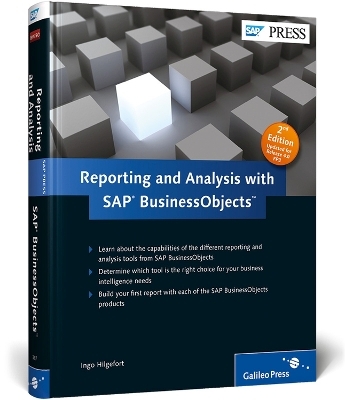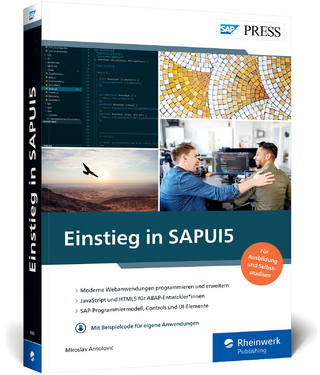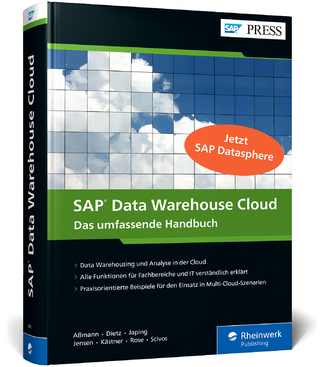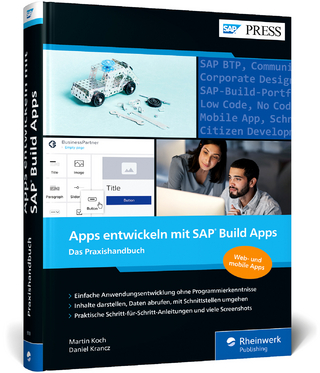
Reporting and Analytics with SAP BusinessObjects
SAP Press (Verlag)
978-1-59229-387-2 (ISBN)
- Titel ist leider vergriffen;
keine Neuauflage - Artikel merken
Best Practices Ensure that you get the most for your time and money by learning the best practices for working with SAP BusinessObjects BI tools. Changes in SAP BusinessObjects 4.0 FP3 Stay up to date on the latest changes in SAP BusinessObjects 4.0, including feature pack 3, such as the introduction of the BI launch pad and BI workspaces. Future Outlook Get a sneak peek at what SAP is working on for future releases of the SAP BusinessObjects BI platform.
Ingo Hilgefort started with Crystal Decisions in Frankfurt, Germany in the year 1999 as a Trainer and Consultant for Crystal Reports and Crystal Enterprise. With the acquisition of Crystal Decisions by BusinessObjects he moved into the Product Management role for the integration between the BusinessObjects product portfolio and SAP.
Introduction 13
1 Introduction to the SAP BusinessObjects Reporting and Analysis Tools 19
1.1 Overview of the SAP BusinessObjects Tools 19
1.1.1 Reporting SAP Crystal Reports 20
1.1.2 Dashboards and Visualization SAP BusinessObjects Dashboards 22
1.1.3 Interactive Analysis SAP BusinessObjects Web Intelligence 24
1.1.4 Analysis SAP BusinessObjects Analysis 26
1.1.5 Data Exploration SAP BusinessObjects Explorer 27
1.2 Other Capabilities of the SAP BusinessObjects Tools 28
1.2.1 SAP BusinessObjects BI and Microsoft Office 28
1.2.2 SAP BusinessObjects BI and Mobility 30
1.3 Summary 30
2 Customer Requirements and Usage Scenarios 31
2.1 General Guidelines for Establishing Business Requirements 31
2.2 Matching Business Requirements to BI Products 33
2.2.1 Financial Reporting and Analysis Requirements 33
2.2.2 Sales Reporting and Analysis Requirements 35
2.2.3 Human Resources (HR) Reporting and Analysis Requirements 36
2.2.4 C-Level Management and Leadership Reporting and Analysis Requirements 36
2.3 Mapping SAP BusinessObjects BI Tools to Capabilities 37
2.4 Mapping SAP BusinessObjects Tools to the Audience 42
2.5 Summary 48
3 The Role of the Semantic Layer 49
3.1 Semantic Layer Technology 49
3.2 Data Connectivity Options for SAP Systems 53
3.3 Recommendations for Semantic Layer Usage 55
3.4 Summary 56
4 Enterprise Reporting with SAP Crystal Reports for Enterprise 57
4.1 SAP Data Connectivity 57
4.2 Assessing the Business Requirements 62
4.2.1 Financial Reporting and Analysis Requirements 63
4.2.2 Sales Reporting and Analysis Requirements 63
4.2.3 Human Resources (HR) Reporting and Analysis Requirements 64
4.2.4 C-Level Management and Leadership Reporting and Analysis Requirements 65
4.3 Introduction to the Tool 65
4.3.1 SAP Crystal Reports for Enterprise Designer Environment 66
4.3.2 Data Explorer 69
4.3.3 Establishing a Connection to SAP NetWeaver BW 70
4.3.4 Groupings 78
4.3.5 Section Expert 80
4.3.6 Conditional Formatting 81
4.3.7 Saving to SAP BusinessObjects 86
4.4 Building a Report for Financial Analysis 87
4.5 Building a Report for HR Analysis 101
4.6 Summary 118
5 Interactive Analysis with SAP BusinessObjects Web Intelligence 119
5.1 SAP Data Connectivity 119
5.2 Assessing the Business Requirements 124
5.2.1 Financial Reporting and Analysis Requirements 124
5.2.2 Sales Reporting and Analysis Requirements 126
5.2.3 Human Resource (HR) Reporting and Analysis Requirements 126
5.2.4 C-Level Management and Leadership Reporting and Analysis Requirements 127
5.3 Introduction to the Tool 128
5.3.1 Creating Your First Report 128
5.3.2 Using Filters 141
5.3.3 Arranging Objects 147
5.3.4 Using Breaks, Sections, and Summaries 151
5.4 Building a Report for Sales Analysis 154
5.5 Building a Report for Financial Analysis 170
5.6 Summary 179
6 Dashboarding and Data Visualization with SAP BusinessObjects Dashboards 181
6.1 SAP Data Connectivity 181
6.2 Assessment of Business Requirements 189
6.2.1 Financial Reporting and Analysis Requirements 189
6.2.2 Sales Reporting and Analysis Requirements 190
6.2.3 Human Resources (HR) Reporting and Analysis Requirements 192
6.2.4 C-Level Management and Leadership Reporting and Analysis Requirements 192
6.3 Introduction to the Tool 193
6.3.1 SAP BusinessObjects Dashboards Designer Overview 193
6.3.2 Setting Up Your Environment 195
6.3.3 Role of Microsoft Excel 198
6.3.4 Common Look and Feel 199
6.3.5 Creating Your First Dashboard 200
6.4 Building a Dashboard for Sales Planning 224
6.5 Summary 250
7 Using SAP BusinessObjects Analysis, Edition for Microsoft Office 251
7.1 SAP Data Connectivity 251
7.2 Assessing the Business Requirements 256
7.2.1 Financial Reporting and Analysis Requirements 256
7.2.2 Sales Reporting and Analysis Requirements 257
7.2.3 Human Resources (HR) Reporting and Analysis Requirements 258
7.2.4 C-Level Management and Leadership Reporting and Analysis Requirements 258
7.3 Introduction to the Tool 259
7.4 Building a Workbook for Financial Analysis 272
7.5 Building a Workbook for Sales Analysis 284
7.6 Summary 295
8 Using SAP BusinessObjects Analysis, Edition for OLAP 297
8.1 SAP Data Connectivity 297
8.2 Assessing the Business Requirements 302
8.2.1 Financial Reporting and Analysis Requirements 302
8.2.2 Sales Reporting and Analysis Requirements 303
8.2.3 Human Resources (HR) Reporting and Analysis Requirements 304
8.2.4 C-Level Management and Leadership Reporting and Analysis Requirements 304
8.3 Introduction to the Tool 305
8.4 Building a Workbook for Financial Analysis 317
8.5 Building a Workbook for Sales Analysis 327
8.6 Summary 338
9 Data Exploration and Searching with SAP BusinessObjects Explorer 339
9.1 SAP Data Connectivity for SAP BusinessObjects Explorer 339
9.2 Assessing the Business Requirements 344
9.2.1 Financial Reporting and Analysis Requirements 344
9.2.2 Sales Reporting and Analysis Requirements 345
9.2.3 Human Resource (HR) Reporting and Analysis Requirements 346
9.2.4 C-Level Management and Leadership Reporting and Analysis Requirements 346
9.3 Introduction to the Tool 347
9.4 Creating an Information Space for Sales Analysis 368
9.5 Summary 383
10 Using SAP BusinessObjects Live Office 385
10.1 SAP BusinessObjects Live Office Configuration 385
10.2 SAP BusinessObjects BI Platform Content and Microsoft Office 387
10.3 Introduction to the Tool 388
10.3.1 SAP BusinessObjects Live Office Environment 388
10.3.2 Using SAP BusinessObjects Live Office and Microsoft Excel 391
10.3.3 Using SAP BusinessObjects Live Office and Microsoft PowerPoint 404
10.3.4 Using SAP BusinessObjects Live Office and Microsoft Outlook 404
10.3.5 Using SAP BusinessObjects Live Office and SAP BusinessObjects Explorer 410
10.4 Summary 419
11 Using SAP BusinessObjects BI Workspaces 421
11.1 Overview 421
11.2 Creating Content for Your First SAP BusinessObjects BI Workspace 427
11.3 Creating Your First BI Workspace 440
11.4 Summary 447
12 Navigating the BI Launch Pad 449
12.1 User Authentication 449
12.2 User Interface (UI) Overview 452
12.3 Folders and Categories 455
12.4 Using Search in the BI Launch Pad 456
12.5 Configuring User Preferences 462
12.6 Summary 467
13 Best Practices and Tips and Tricks for SAP BusinessObjects BI Tools 469
13.1 Selection of the Right Tool 469
13.2 SAP NetWeaver BEx Query Design 470
13.2.1 Relationship: BEx Query and Report 470
13.2.2 Elements of an SAP NetWeaver BEx Query 471
13.2.3 Using Variables in a BE Query 473
13.2.4 Display Relevant Settings 473
13.3 Data Connectivity 475
13.4 User Security 478
13.5 Performance Considerations 479
13.6 Known Limitations 481
13.7 Report Design Topics 488
13.8 Tracing and Troubleshooting 488
13.9 Summary 489
14 Integration Outlook 491
14.1 SAP Crystal Reports for Enterprise 491
14.2 SAP BusinessObjects Dashboards 492
14.3 SAP BusinessObjects Web Intelligence 492
14.4 SAP BusinessObjects Analysis Suite 492
14.5 SAP BusinessObjects Explorer 492
14.6 Semantic Layer 493
14.7 Summary 493
The Author 495
Index 497
| Erscheint lt. Verlag | 30.1.2012 |
|---|---|
| Reihe/Serie | SAP PRESS Englisch |
| Verlagsort | Maryland |
| Sprache | englisch |
| Maße | 175 x 228 mm |
| Themenwelt | Mathematik / Informatik ► Informatik ► Netzwerke |
| Informatik ► Weitere Themen ► SAP | |
| ISBN-10 | 1-59229-387-5 / 1592293875 |
| ISBN-13 | 978-1-59229-387-2 / 9781592293872 |
| Zustand | Neuware |
| Haben Sie eine Frage zum Produkt? |
aus dem Bereich


